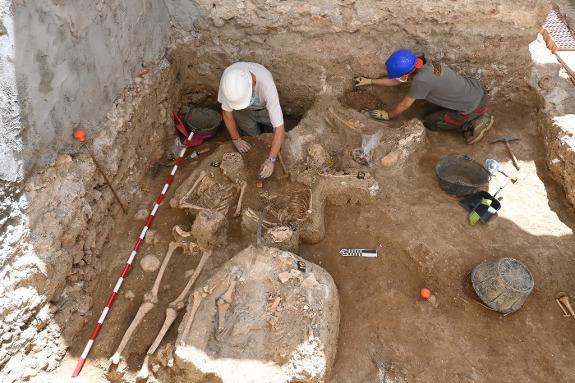

Sections
Highlight

Héctor Barbotta
Saturday, 27 June 2020, 13:20
Compartir
Work on the foundations of the old La Fonda hotel and restaurant in Marbella Old Town, which is being restored, has uncovered remains which may provide previously unknown information about the town's history.
These include the walls of the old San Sebastián church, which was demolished in the 16th century, 18th century paintings and a necropolis with common graves dating back to the time of a pandemic during which bodies had to be buried urgently.
Archaeologists say this would have been in the late 16th and early 17th century. They have also found signs of conventional burials with remains of ceramics from the same period and associated with the church.
Work on La Fonda, which is in Calle Ancha, began in February. The establishment was very popular in the early days of tourism in Marbella but has been abandoned for years. Now, however, a foreign investor has acquired the building and wants to convert it into a boutique hotel. The remains which have come to light are from three buildings below La Fonda, opening onto Calle Santo Cristo and Calle Bermeja. The archaeologists believe the necropolis extends quite a way beyond this site. The remains of at least 20 people have been found so far and there will probably be others.
The same family
Seven of the skeletons were found in the same place: three adults and four children. Tests will be carried out to see if they were members of the same family, which is the most probable hypothesis, and whether they died from the illness (if it has left traces in their bones), says archaeologist Miguel Vila, who is directing the works. This would confirm what type of epidemic affected Marbella between the late 16th and early 17th century. Historian Catalina Urbaneja has already collated information to indicate that there was bubonic plague in the town between 1600 and 1602.
The remains of a building found in the Calle Bermeja area are known to be the 16th-century San Sebastián church. Miguel Vila says it was a simple building which began to be restored early on but didn't survive for long. Experts were aware of the church's existence after studies carried out in 2016 showed the presence of several structures.
The paintings which have been found, from the late 17th to the early 19th century, also reflect the historical relevance of this location. Calle Ancha, which runs north of the Old Town, was an important street with numerous large houses and heraldic shields on their façades. The paintings are to be restored and will be integrated into the new hotel.
Vila says these three elements - the walls of the San Sebastián church, the human remains which prove the existence of a necropolis in the upper part of the town and the paintings - are very important because they will help to explain a large part of Marbella's history.
However, he also stresses that the works have only just begun to be carried out and it is possible that there will be other discoveries as well, including another necropolis which is thought to have existed in the times of the Moors.
Publicidad
Publicidad
Publicidad
Publicidad
Reporta un error en esta noticia
Necesitas ser suscriptor para poder votar.